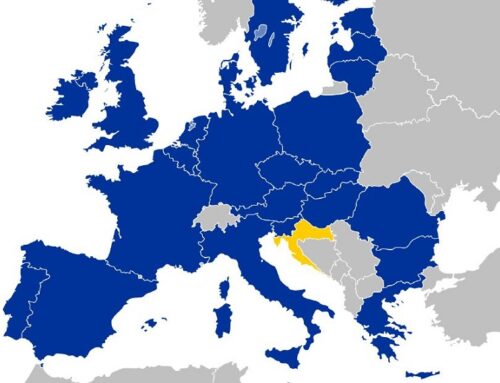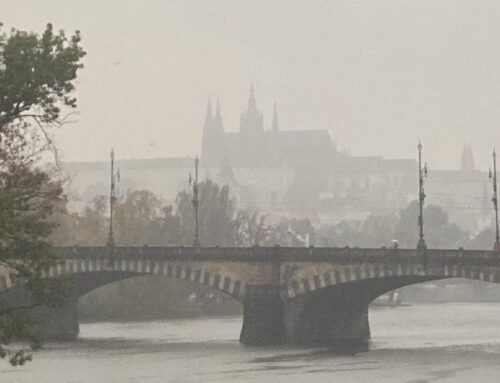After the collapse of soviet regimes in Central European states they had to undergo significant changes in all spheres of their social structure. The evolution of political landscapes is probably the most crucial among them, as it directly influenced the direction of their further development. As we can see today, party systems of these countries have demonstrated high dynamism as in just 20 years they have changed numerous times, from integrated democratic movements of late 80s to the formation of traditional center-left and center-right parties and later to the rise of popularity of populists and further fight between antipopulist coalitions with them. In this article I examine how party systems of Visegrád states evolved with time, determing their specificities and common regional trends.
Czech Republic

1989-1998: high consolidation of political arena, strong right wing
Velvet revolution of 1989 resulted in the collapse of socialist mono-partisan system and the emergence of new political players. Initially the major democratic power in Czechia was Civic Forum (OF). By winning 1990 elections to Federal Assembly of Czechoslovakia and to Czech National Council it secured a dominant role at Czech political arena. On both of them it received about half of votes (for comparison, Communist Party only managed to get 13-14% of them). It is important to mention that from the very beginning Czech and Slovak party systems developed separately and so had some differences even before 1993. In Czech Republic the overintegrated party system with the dominant role of Civic Forum started to undergo subsequent changes and at 1992 parliamentary elections 8 parties were elected to Czech parliament with ODS-KDS coalition (direct successor to Civic Forum) winning and getting nearly 30% of votes.
By 1996 Czech political landscape took a traditional bipolar form with strong right-center (ODS) and left-center (ČSSD) parties that have approximately equal support and changed each other in government. However, it is worth mentioning that until 1998 legislative elections Czech right wing of political spectrum was substantially more powerful, as ČSSD was the only left-wing party in the parliament apart from politically isolated communist party (KSČM). First two cabinets of independent Czech Republic (both formed by prime minister Václav Klaus) were formed by ODS, ODA and KDU-ČSL. During this period Václav Havel, a former political dissident and the founder of Civic Forum, was Czech President. Even though the Czech Republic is a parliamentary republic, Vaclav Havel actively used his position to promote Czech Republic, especially in foreign policy realm[1].
1998-2013: political landscape turning left, power becomes evenly distributed between ČSSD and ODS
In 1998 ČSSD managed to win the elections for the first time. However, since it was the only left-wing party in the parliament, it faced problems in forming a coalition. Eventually leader of ČSSD Miloš Zeman reached an Opposition agreement with its main competitor ODS. This formally allowed Zeman to form a government although ODS reserved a right to remain in opposition to government. A minority government was created. During next legislative elections in 2002 ČSSD won again by a larger margin than previously. However, at 2003 presidential elections ODS candidate Václav Klaus won over ČSSD candidate. He also managed to repeat his success at 2008 presidential elections. At 2006 legislative elections ODS returned its leading position, even though both of the main parties performed well. The results of the elections were influenced by scandals around ČSSD, as its members were accused of corruption and interference in police investigations. Despite of that, ČSSD managed to form a cabinet with the support of KDU-ČSL and US-DEU. However, due to a corruption scandal around prime minister Stanislav Gross[2] it was later dissolved which provided ODS with an opportunity to form the government in 2007 and eventually form a coalition with KDU-ČSL and Green Party. The perturbations of this period demonstrate equal division of powers among two major political parties, which negatively influenced coalition-forming process as neither of them was able to easily form a majority government. After 2010 legislative elections (won by ČSSD) ODS contunied to stay in power in the coalition with a new liberal-conservative party TOP 09 and a new anti-rstablishment party Public Affairs. The emergence of the latter is a significant mark for Czech political landscape: continuous corruption scandals and coalition forming difficulties resulted in the rise of anti-establishment moods in Czechia, which later resulted in an outstanding support for anti-establisment populist ANO.
2013: rise of populism and decline of traditional parties
The new period of political development of Czech Republic began in 2012-2013 with the establishment of ANO by Czech entrepreneur Andrej Babiš, which was a qualitively different political force from those that existed since 1990s. It positioned itself as centrist (although its latter anti-immigrant rethoric demonstrated its more right-wing positioning) and focused mainly on fighting corruption and enhancing economic development. ANO performed well at 2013 legislative elections, getting 18,66% of votes. ČSSD, which won the elections, formed a coalition with ANO and KDU–ČSL. The positions of the government were strengthened by the victory of Miloš Zeman at 2013 presidantial elections, who supported ŠSSD-ANO coalition. At the same time, the positions of ODS significantly weakened due to political scandals around the party[3], which put it into a serious crisis. As a result a total rebranding of ODS took place in the middle of 2010s under its new leader Petr Fiala. 2017 legislative elections showed that Czech political landscape changed dramatically. Both ČSSD and ODS performed bad, even though the latter managed to improve its positions under new leadership. At the same time, ANO won the elections with 29,64% of votes, far ahead of its rivals. Apart from that, a number of new parties such as liberal progressive Pirates, right-wing populist SPD and liberal to liberal conservative STAN emerged on the political arena. As a result, a minority coalition of ANO and ČSSD with the support of KSČM was formed. It pushed anti-immigrant eurosceptic agenda with the support of Miloš Zeman.
The decline of traditional parties meant that they were no longer able to reach high results at the elections on their own, especially given high and stable electoral support for ANO. Apart from this, new political forces such as Pirates and STAN also did not have enough support to become key political forces independently. Therefore, a process of forming coalitions started to take place. Two coalitions were formed- one for traditional parties- SPOLU (ODS, KDU–ČSL, TOP 09) and another for new parties- Pirates and Mayors (Pirates and STAN). At 2021 legislative elections SPOLU and Pirates and Mayors grouped together to fight ANO and posed themselves as pro-european forces in contrast to eurosceptic ANO. Even though the latter won 2021 legislative elections, a government of two coalitions was formed. Apart from that, at 2023 presidential elections Petr Pavel, a candidate from two coalitions, beat Babiš, which was a further blow for ANO. Despite of that the new government consisted of a wide range of diffirently-oriented parties, it proved to be functional and stable, which shows that orientation of the parties in pro-european/eurosceptic register has become more important for them then in left/right register.
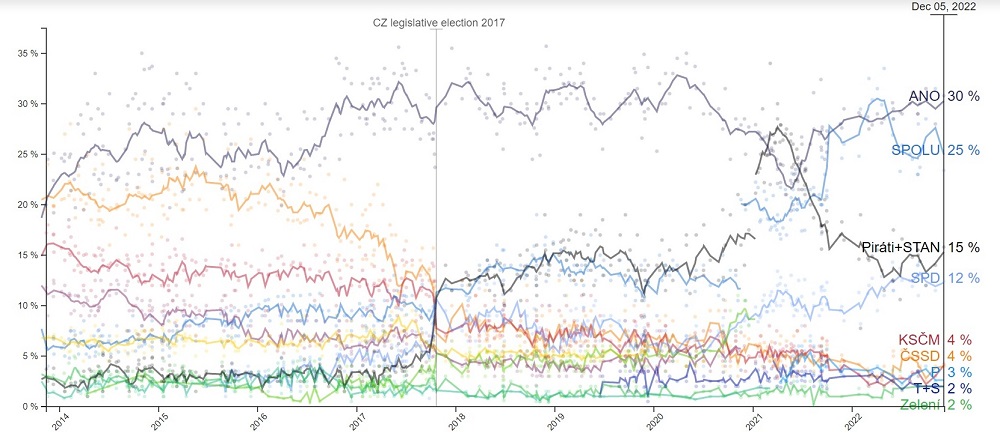
Current political landscape in Czech Republic according to polls[4]
Poland

1989-2005: fragmentation of political arena, general left orientation
The democratic development of Polish political landscape began in 1989, when for the first time non-socialist political force- Solidarity movement- was allowed to take part in legislative elections as a result of massive protest. Polish communist party tried to strengthen the legitimacy of regime by creating non-communist opposition. Solidarity performed surprisingly well and got 35% of votes. After the dissolution of Polish United Workers’ Party in 1990 and fall of communist regime first free legislative elections were held in 1991. The collapse of Solidarity movement resulted in fragmentation of political arena with strong parties both on the right (Christian democratic UD, right-wing WAK) and left (social-democratic SLD) part of political spectrum as well as strong agrarian party PSL. Initially Christian democrats enjoyed the biggest support among population, however in 1993 PSL in coalition with left parties managed to form a government coalition. Apart from that, in 1995 SLD candidate Aleksander Kwaśniewski won presidential elections, which further strengthened the position of left political forces. He repeated his success at 2000 presidential elections. At 1997 elections PSL lost power to AWS, a broad coalition of parties of different political orientation, which based itself on the heritage of Solidarity movement. Left SLD-UP one elections in 2001, getting 41% of votes and formed a coalition with PSL. Generally one can easily spot that during 1990s and early 2000s Polish political field remained mostly left-oriented (in contrast to Czech Republic).
2005-2015 liberal period
2005 legislative elections brought a major turn for Polish political arena. Support of SLD declined dramatically and best results were demonstrated by right-wing PiS (27%) and liberal Civic Platform (24,1%). This changes was caused by corruption scandals around the ruling party[5] and unsatisfactory results of economic policy. PiS formed a coalition with nationalist SRP and conservative LPR. On top of that, PiS candidate Lech Kaczyński one over Civic Platform candidate at 2005 presidential elections. However, conservative government did not last long due to political scandals around Andrzej Lepper, leader of the SNP. At 2007 legislative elections Civic Platform one over PiS (41,5% to 32,1%) and formed government with PSL. Practically it replaced SLD on the position of left pole of political spectrum. It is also worth mentioning that such high results of the two main parties demonstrates that after political fragmentation of 1990s, consolidation started to take place in 2000s. The government of Donald Tusk (leader of Civic Platform) proved to be stable, especially in comparison to turmoils of previous governments, and Civic Platform one elections again in 2011. It was also successful at 2010 presidential elections, as its candidate Bronisław Komorowski won over Jarosław Kaczyński, the leader of PiS after the death of his brother Lech.
2015- conservative period and revitalization of liberal opposition
At 2015 legislative elections PiS managed to beat Civic Platform (37,58% to 24,09%) due to scandals around the latter, economic policies of the government aimed at avoiding recession that implied social expenses shortages and migrant crisis. It was the first time in modern Polish history when one party was able to win a majority in Parliament. PiS also beaten Civic Platform at 2015 presidential elections, with its candidate Andrzej Duda winning over Komorowski. PiS repeated it parliamentary success at 2019 legislative elections and even strenghtened its positions with the overwhelming support of 43,6% of voters. It is worth mentioning that by this time Polish political arena started to undergo the same process as in Czech Republic- parties unable to reach high results on their own started to form broad coalitions. At 2019 elections all of main political actors formed their coalitions (PiS- United Right, Civic Platform- Civic Coalition, SLD- The Left, PSL- Polish Coalition). The second government of PiS faced increasing pressure from various political scandals and worsening relations with Brussels with the latter blocking funds needed by Poland for post-pandemic recovery as Brussels was becoming increasingly bothered with the state of Polish judiciary system[6]. By 2023 PiS founds itself in a complicated position: even though, according to polls, it still enjoys the highest level of public support (around 35%), its main liberal competitor- Civic Coalition- is not far behind and is theoretically capable of forming a coalition with a new centrist party Poland 2050 and Polish Coalition and so win the majority in Parliament. Therefore, the scenario of Czech 2022 elections may be repeated in Poland in 2023 when a broad center-to-left coalition wins over right-win populists. As Czech scenario proves, even though crafting such a broad coalition is not easy, it is still a viable option not only in terms of elections but also in terms of functioning government.
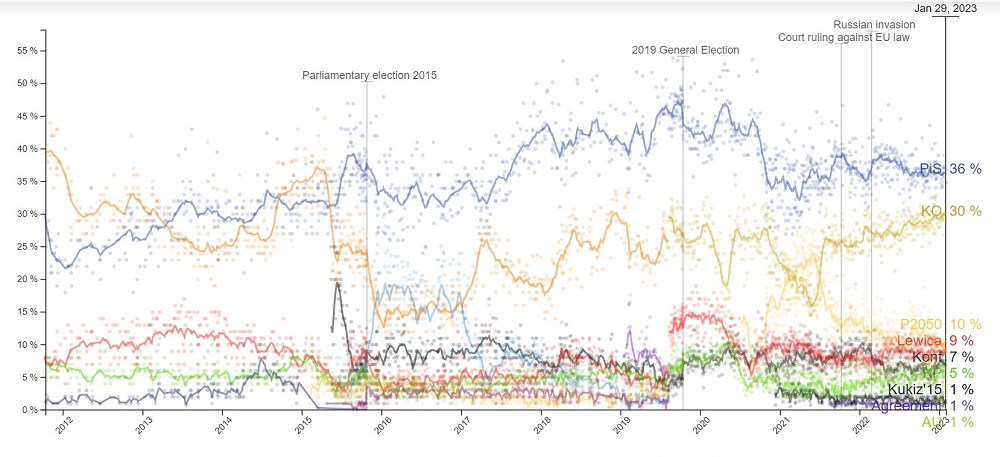
Current political landscape in Poland according to polls[7]
Hungary

1989-2010: bipolarity of right and left poles of political spectrum
The early years of Hungarian democratic party system, which emerged as a result of a peaceful transition from communist regime to democracy in 1989, was characterized by its multipolarity from the very beginning (in contrast to Czech Republic and Poland). At 1990 legislative elections 6 parties, which represented a wide range of political spectrum from the winner of elections right-wing MDF to successor to communist party social-democratic MSZP, were elected to Parliament. As a result a government of MDF, agrarian FKGP and Christian democratic KDNP was formed. At 1994 elections MSZP enjoyed the highest support among voters and formed a government coalition with SZDSZ. The whole center-to-right political sector received much lower support from voters. The shift was caused mainly by poor results of early stage of economic reforms. It was at this time that Victor Orbán, the leader of Fidesz, decided to adopt liberal conservatism as party strategy. It paid off well for his party as after left-wing coalition’s mostly unsuccessful time in power a demand for right-wing parties grew again. At 1998 elections Fidesz received 29,48% of votes and Orbán formed a government coalition with agrarian FKGP and right-wing MDF. At 2002 elections Fidesz performed well again with the support of 41,07% voters, which was a sign of major consolidation of right part of Hungarian political spectrum. However, social-democratic MSZP won these elections, receiving 42,05% of votes, and formed a coalition together with SZDSZ. Social-democrats repeated their success in 2006, winning over the alliance of Fidesz and KDNP by a narrow margin and once again forming a coalition with liberal SZDSZ. The crisis of right-wing parties (except for Fidesz) disabled Orbán to bring a viable alternative to MSZP-SZDSZ coalition.
2010- Fidesz political domination
2010 elections were won by Fidesz-KDNP alliance with the overwhelming support of 52,73% of voters. Apart from that, a new radical right party Jobbic received 16,67% of votes. At the same time, social democrats received only 19,3% of votes due to lost credibility in connection with various political scandals. Liberal SZDS almost disappeared from the political arena. Public support for Fidesz remained high due to stable economic growth and conservative cultural agenda, welcomed by many Hungarians. Later in the context of migrant crisis Fidesz also embraced anti-immigrant rhetoric, typical for right-win populists. Apart from this, Fidesz initiated a number of electoral reforms that could potentially benefit it at the elections[8]. As a result, Fidesz once again repeated its success at 2014 elections, even though with lower support of 44,87% of voters. Left-wing parties formed an alliance Unity that got 25,57% of votes. The right shift of political arena became even more pronounced at 2018 legislative elections, when Fidesz-KDNP received the support of 49,27% of voters, while left-wing parties altogether received the support of less than 20% of population. This symbolized a systematic crisis, in which Hungarian liberal opposition found itself by the end of 2010s. As in Czech case, this led to the emergence of abroad coalition- United for Hungary- which managed to get 34,44% of votes at 2022 elections. At the same time, Orbán with 54,13% remained far ahead of its rivals. One is bound to admit that in comparison to Czech and Polish cases liberal forces in Hungary struggle to win over right-wing populists even within a broad coalition format. As a result, the broad anti-Fidesz coalition was dissolved soon after its 2022 defeat and currently the liberal sector of Hungarian politics is dominated by Democratic Coalition.
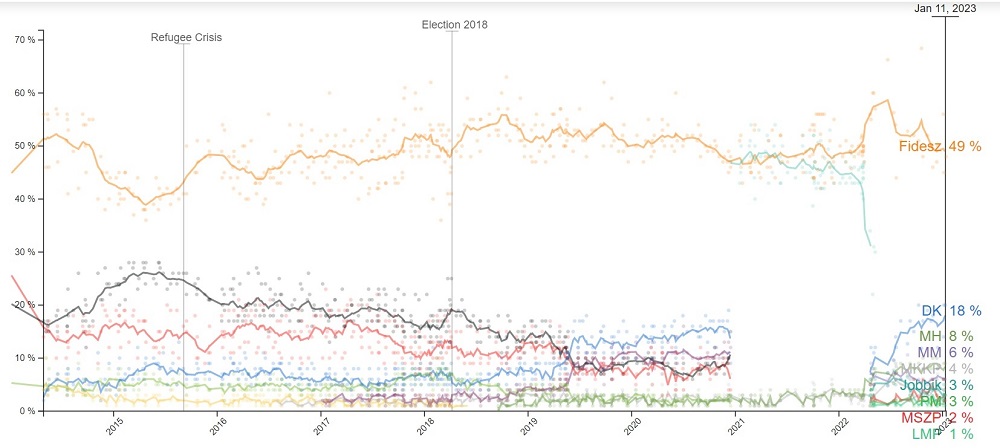
Current political landscape in Hungary according to polls[9]
Slovakia
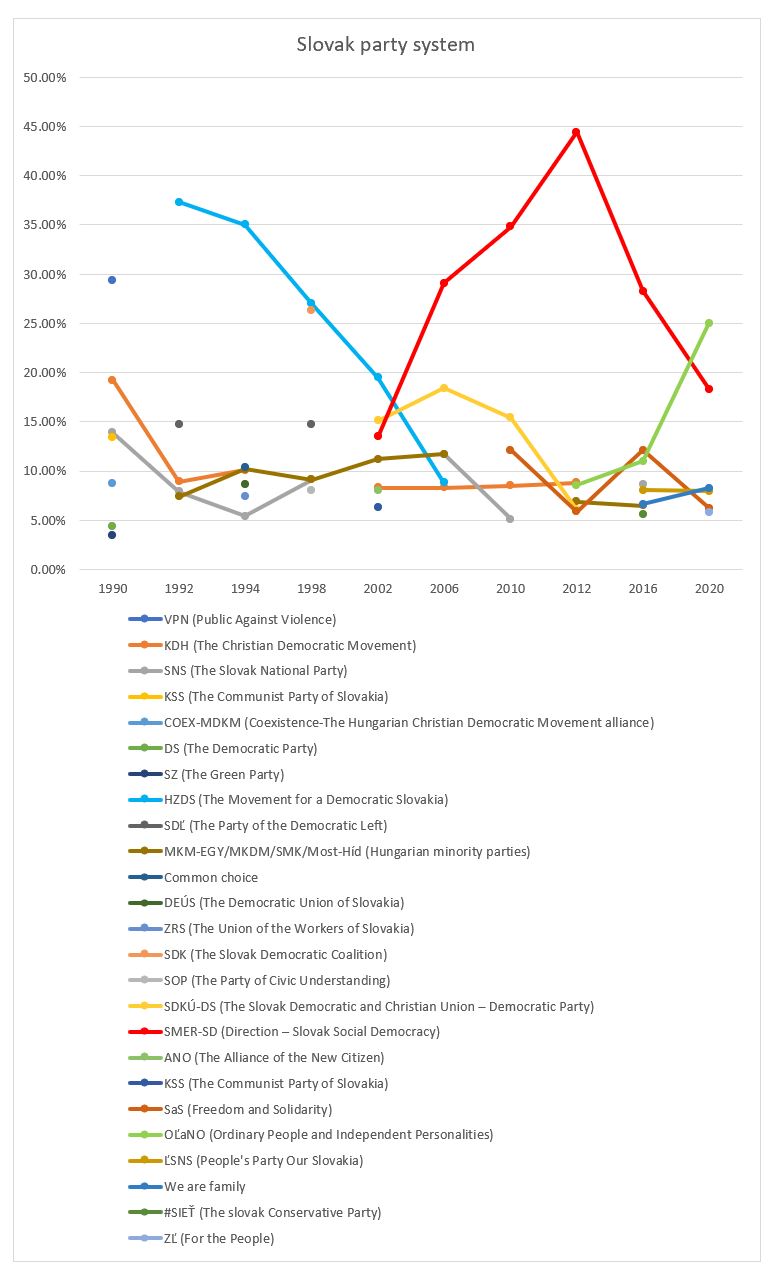
1990-1998: Mečiar period
As was mentioned above, Slovak political landscape developed independently from Czech one from the very beginning and substantially differed from it. While in Czechia political arena was initially highly integrated in the form of Civic Forum, in Slovakia at 1990 legislative elections 5 parties managed to get to Parliament with Public against violence (VPN) winning elections by recieving 29,4% of votes. Generally political spectrum was initially center-right, same as in Czechia, however with a stronger far-right sector. As a result of elections a broad government coalition of centrist VPN, Christian-democratic KDH and center-right Democratic Party were formed. Our of coalition remained only nationalist SNS and communist KSS. Even though the government formed by Vladimír Mečiar did not survive long, as he was withdrawn from office in 1991, Mečiar’s national-populist Movement for a Democratic Slovakia (HZDS) won 37,3% of votes in 1992, far ahead of its rivals, and formed a minority government with nationalist SNS. Mečiar’s governance raised doubts about the effectivity of democratization process in Slovakia and the state of rule of law in the country, as well as tensions with Western partners, however public support of the party remained high and after the recall of Mečiar’s government and new elections in 1994, HZDS formed a new coalition with radical-left ZRS and nationalist SNS. This was the first moment for Central Europe when right populist, eurosceptic party that enjoys high support among population comes to power and traditional centrist parties struggle to beat it on their own. Same as in Czech case, Hungarian case and potentially- in Polish case- this led to the creation of a broad coalition named Slovak democratic coalition. HZDS took the threat seriously and tried to raise number of votes for coalition that enables it to enter parliament to 25%. As a result, SDK changed it status from coalition to party under the leadership of Mikuláš Dzurinda. At 1998 elections HZDS received 27% of votes, while SDK- 26,3% and the latter managed to form a coalition with social-democratic SDĽ, Party of the Hungarian coalition (SMK) and center-left SOP. In practice this meant political isolation of populist HZDS and nationalist SNS. The case of 1998 Slovak elections looks extremely similar to 2022 Czech elections, when the whole political spectrum except for nationalist SPD formed a coalition to beat its right-wing populist rival. Even though differences do exist- including lower level of tensions between ANO and the EU, the absence of experience of cooperation between ANO and SPD (while HZDS and SNS formed two government coalitions), one is bound to see a general patter, which, I believe, has substantial normative value.
1998-2016: populists against Christian democrats
The coalition that came to power did not last long and was eventually dissolved, however Christian-democratic SDKÚ under the leadership of Mikuláš Dzurinda at 2002 elections remained the most popular party after HZDS and since the latter remained in political isolation, managed to form the new government with SMK and a new center-right ANO party. Generally by this time Christian-democratic sector of Slovak political spectrum became dominant, despite of success of a new left-wing SMER party. However, with time Christian democrats started to loose support due to a number of political scandals[10]. As a result, at 2006 elections SMER-SD won 29,1% of votes , while SDKÚ-DS- only 18,4% and formed a coalition with ĽS–HZDS and SNS. This meant that a broad coalition of left and right populists managed to beat Christian democrats and came to power again. However, by 2010 legislative elections the political landscape changed again. ĽS–HZDS almost disappeared from political spectrum as a result of a long process of losing electoral support. SMER-SD, even though it won elections with the support of 34,8% of voters, was not able to form a government, since SNS also performed bad. As a result, predominantly Christian democratic cabinet with the leading role of SDKÚ-DS was formed. However, the positions of the new government were damaged by a number of political scandals as well as controversies connected with voting on whether to approve the expansion of the European Financial Stability Fund. The government received no confidence vote and at 2012 elections SDKÚ-DS only got 6,09% of votes. At the same time, Fico’s support grew substantially and his party received 44,41% of votes and for the first time since 1990 formed a one-party government.
2016- fragmentation and high volatility as signs of a party system crisis
By 2016 Slovak political field underwent some substantial changes. Even though SMER-SD remained the leader, its support declined to 28,28%, therefore it had to form a government coalition with SNS and Most–Híd, the successor of SMK. Much more substantial changes happened on the opposite side of political spectrum. By this time traditional Christian democratic parties lost most of their support and were replaced by center-right parties SaS, OľaNO, We are family and Slovak Conservative Party, most of them incorporating elements of populist and anti-corruption rhetoric. In practice this meant that the real binary orientation of political arena, whether it is left/right, populist/traditional, eurosceptic/pro-european became vague in Slovakia and coalitions were predominantly make ad hock by parties with differentiated political orientation. Apart from that, the far-right wing of political spectrum strengthened with neo-Nazi ĽSNS entering Parliament. By 2020 parliament elections the party system underwent further changes: SMER-SD lost much of its support due to political scandals[11] and received only 18,29% of votes, while OľaNO won the elections with 25,02% of votes. As a result, a cabinet consisting of various center-right parties: OľaNO, We are family, SaS and For the People was formed. Practically the whole Slovak political spectrum (except for neo-Nazi ĽSNS) united against SMER-SD, following the traditional for Slovakia scenario of antipopulist coalitions. However, in 2020 the coalition itself contained a lot of populism and was not as homogeneous as earlier Christian democratic coalitions, which made inter-coalition conflicts highly likely. Both OľaNO-led cabinets (first under Igor Matovič, second under Eduard Heger) faced numerous internal conflicts and external challenges, such as Slovak healthcare crisis[12]. As a result, the government lost no confidence vote in December 2022 and the support for OľaNO declined dramatically to approximately 7%, while the support for its main competitors- Fico’s Smer–SSD and HLAS-SD, a new party that split from SMER in 2020, rose to 15-20% of votes each. Apart from that, in the last months centrist Progressive Slovakia has begun to strengthen its support rapidly with already reaching 13%. If the trend continues, it may reach the level of Smer and HLAS or even beat them.
War in Ukraine brought Slovak political field an opportunity to form a new binary political system, with left populists Smer and HLAS opposing EU’s support for Ukraine, while a branch of centrist parties supporting European approach. As for upcoming 2023 legislative elections, the victory of left-wing populists seems more probable, as public support for center-to-right group of parties is in decline. The potential configuration of coalitions are Smer+HLAS+Republica, that replaced ĽSNS in the far-right place of political spectrum, united by eurosceptic agenda, against Progressive Slovakia, We are Family, OľaNO, SaS and KDH. According to most recent polls, the distribution of votes could be 44%-39% in favor of eurosceptics. However, given recent high volatility of Slovak political arena one should be careful about making any predictions in this regard.
The overall state of Slovak party system reminds us Czech, Polish and Hungarian cases and brings to a conclusion that eurosceptisicm/pro-european identification has become a core point of binarisation of political systems in Visegrád countries. However, while in Czech Republic and Poland the total number of pro-european voters seem to outnumber eurocpetics, in Hungary and potentially in Slovakia pro-european forces seem to be unable to outnumber eurosceptic populists even in the form of broad coalitions.
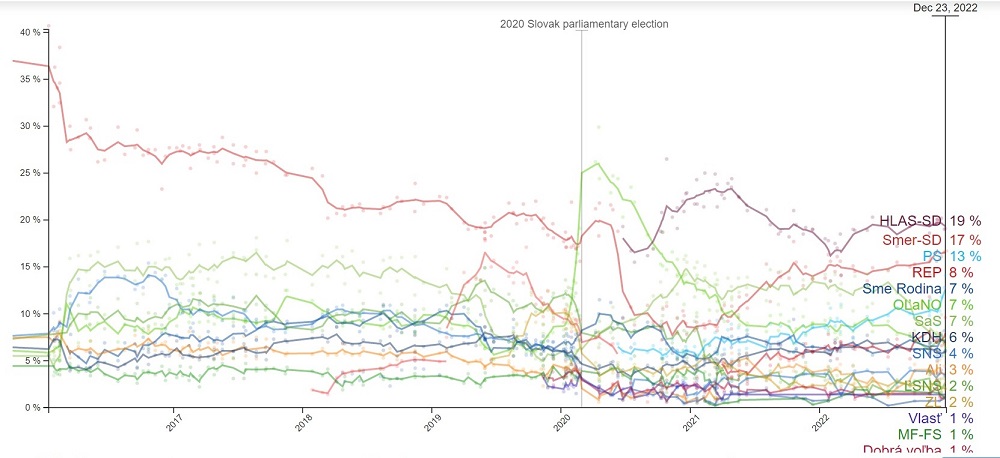
Current political landscape in Slovakia according to polls[13]
Regional trends
On the basis of the analysis of political party system of Central European countries two conclusions about the regional political trends can be made.
- There has been a change of the essence of binary division of party systems in the countries examined. In Czech Republic, Hungary and Poland initially a binary system of left and right parties existed. In Czechia and Hungary right pole was the leading one, while in Poland left pole was more successful. With time the situation began to change, mainly due to that countries entered the EU and faced challenges in a number of questions in relations with Brussels such as migrants, culture and values as well as some economic issues. Therefore, eventually party policy on union track has become a more important marker then its left-right orientation, which is partly reflected by an increasing number of parties that do not identify themselves in left-right register at all (ANO, Pirates[14]) and broad pro-european coalitions (SPOLU+Pirates and Mayors, United for Hungary). In Czech republic, where eurosceptics are the most centrist, and in Slovakia, where eurosceptics form coalitions of social democrats and far-rights, the trend is more pronounced, however it is also visible in the other two countries.
- Central European populism is a natural response to a low quality of political culture. One is bound to notice that a significant number of changes of power in Visegrád countries from one party to another happened not due to the failure of policy or changing economic phase, but because of political scandals, usually based on corruption cases. These scandals undermined public trust in traditional political parties and gave floor to populists. At the same time, populists themselves tend to become a target of political scandals and loose popularity. Therefore, the key factor that determines the distribution of powers among populist eurosceptic and anti-populist pro-european forces is the number of recent political scandals around them, which is especially visible in case of ANO defeats of 2022-2023 and a highly volatile Slovak political system, within which all main political actors on both sides have been targets of recent political scandals. The only exception from this rule is continuous support for Hungarian Fidesz, even though it has received a large amount of criticism about its various policies. This can be attributed to a much higher national resentment among Hungarians than among any other nation examined (it is symptomatic that Poland, which also has a strong nation-oriented feeling, also has a strong right-wing populist party) as well as economic success after a period of troubles. Therefore, generally we can expect the decline of Central European populism to happen no earlier than the level of political culture will rise substantially, destroying the grounds for the key populist idea- opposing the people to elites.
References:
[1] Václav Havel and the 14th Dalai Lama, the story of a friendship and a message for the world.- International Campaign for Tibet. URL: https://savetibet.nl/nieuwsartikel/vaclav-havel-and-the-14th-dalai-lama-the-story-of-a-friendship-and-a-message-for-the-world/
[2] Czech premier offers resignation. – BBC. URL: http://news.bbc.co.uk/2/hi/europe/4428079.stm
[3] Při zátahu našla policie až 150 milionů a desítky kilogramů zlata. – iDnes.cz URL: https://www.idnes.cz/zpravy/cerna-kronika/policie-pri-zatahu-jsme-nasli-150-milionu-a-desitky-kilogramu-zlata.A130614_111235_krimi_jav
[4] Politico: Poll of polls URL: https://www.politico.eu/europe-poll-of-polls/czech-republic/
[5] Bribery case threatens Polish government. – The Guardian. URL: https://www.theguardian.com/world/2003/jun/09/filmnews.poland
[6] Brussels questions Poland’s judicial reforms to unlock EU recovery funds.- my.europe URL: https://www.euronews.com/my-europe/2022/07/01/brussels-questions-polands-judicial-reforms-to-unlock-eu-recovery-funds
[7] Politico: Poll of polls URL: https://www.politico.eu/europe-poll-of-polls/poland/
[8] How to Abolish Democracy: Electoral System, Party Regulation and Opposition Rights in Hungary and Poland.- verfassungsblog.de URL: https://verfassungsblog.de/how-to-abolish-democracy-electoral-system-party-regulation-and-opposition-rights-in-hungary-and-poland/
[9] Politico: Poll of Polls URL: https://www.politico.eu/europe-poll-of-polls/hungary/
[10] Kauzy SDKÚ-DS. – sdkuonline.sk URL: http://sdkuonline.sk/kauzy-sdku-ds/
[11] Jan Kuciak: a murder that changed Slovakia.- balkaninsight.com URL: https://balkaninsight.com/2020/08/05/jan-kuciak-a-murder-that-changed-slovakia/
[12] Slovak health system on verge of collapse. – euroactiv.com URL: https://www.euractiv.com/section/politics/short_news/slovak-health-system-on-verge-of-collapse/
[13] Politico: Poll of Polls URL: https://www.politico.eu/europe-poll-of-polls/slovakia/
[14] Ivan Bartoš: „Politika není pravicová nebo levicová“. – a2larm.cz URL: https://a2larm.cz/2017/06/ivan-bartos-politika-neni-pravicova-nebo-levicova/



